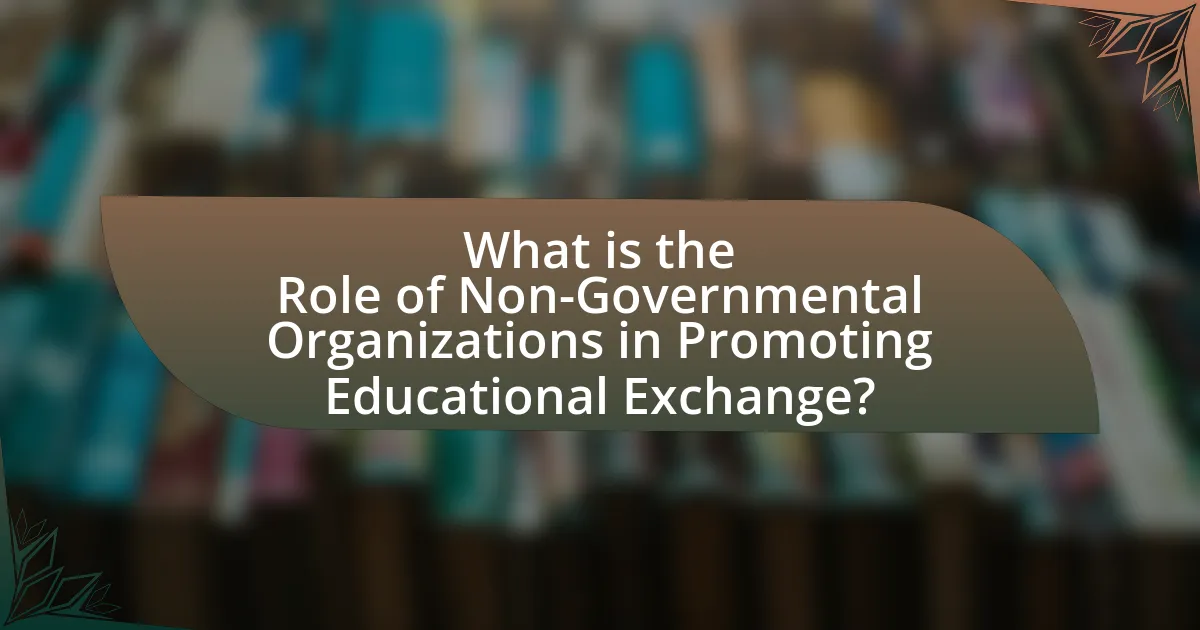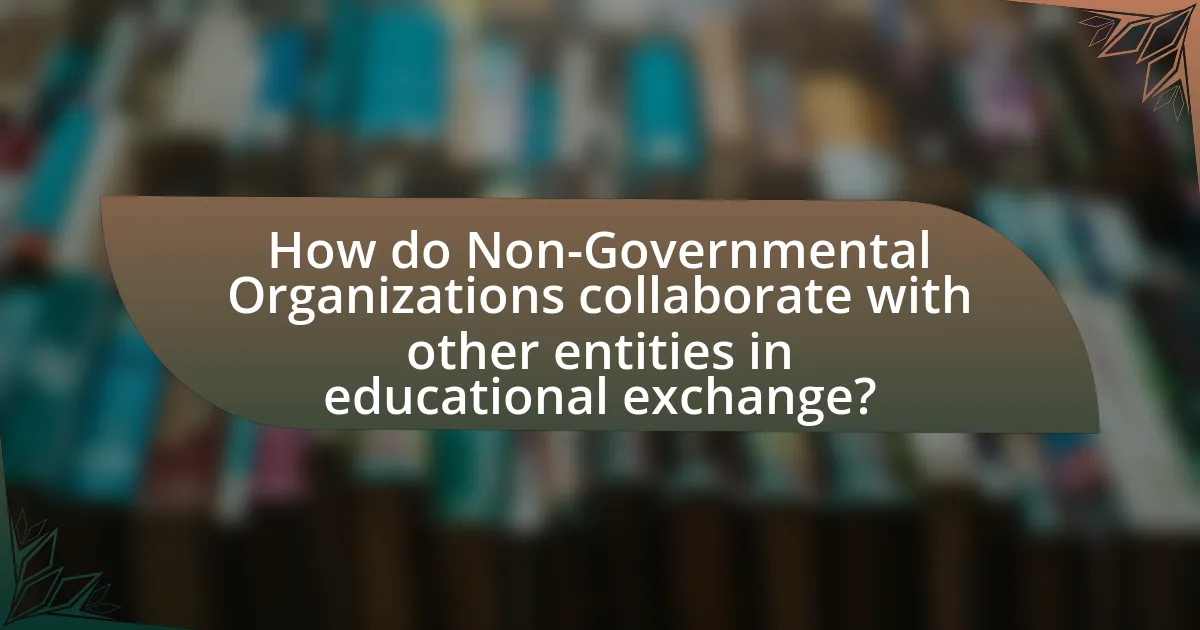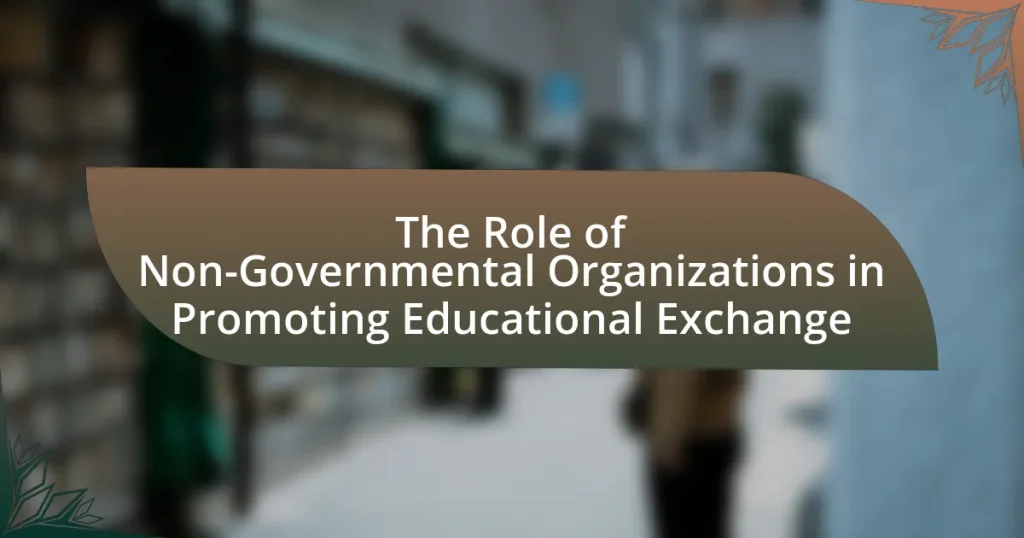Non-Governmental Organizations (NGOs) play a vital role in promoting educational exchange by facilitating cross-cultural interactions and providing essential resources for learning opportunities. They implement various programs, such as scholarships, internships, and cultural exchanges, which enhance access to education and foster global citizenship. NGOs also address gaps in governmental educational policies and collaborate with educational institutions and private sectors to improve educational initiatives. Despite facing challenges like funding limitations and bureaucratic obstacles, NGOs significantly contribute to enriching the educational experience and promoting mutual understanding among diverse communities.

What is the Role of Non-Governmental Organizations in Promoting Educational Exchange?
Non-Governmental Organizations (NGOs) play a crucial role in promoting educational exchange by facilitating cross-cultural interactions and providing resources for learning opportunities. They organize programs that connect students and educators from different countries, fostering mutual understanding and collaboration. For instance, NGOs often establish scholarship programs, internships, and volunteer opportunities that enable individuals to study abroad or host international students. According to a report by the Global Education Monitoring Report, NGOs contribute significantly to increasing access to education and enhancing the quality of educational exchanges, thereby enriching the learning experience for participants.
How do Non-Governmental Organizations contribute to educational exchange?
Non-Governmental Organizations (NGOs) contribute to educational exchange by facilitating cross-cultural programs, scholarships, and partnerships that enhance learning opportunities. For instance, organizations like AFS Intercultural Programs and the Institute of International Education provide platforms for students to study abroad, promoting cultural understanding and academic collaboration. According to the Institute of International Education’s “Open Doors” report, over 300,000 U.S. students studied abroad in 2019, with many programs supported by NGOs, demonstrating their significant role in expanding educational access and fostering global citizenship.
What specific programs do these organizations implement for educational exchange?
Non-governmental organizations implement various specific programs for educational exchange, including scholarship programs, cultural exchange initiatives, and international internship opportunities. For instance, organizations like AFS Intercultural Programs offer high school exchange programs that allow students to study abroad and immerse themselves in different cultures. Similarly, the Fulbright Program, administered by the U.S. Department of State, provides grants for international educational exchange for students, scholars, and professionals, promoting mutual understanding between nations. These programs are designed to enhance cross-cultural communication and provide participants with valuable global perspectives, thereby reinforcing the importance of educational exchange in fostering international cooperation.
How do these programs facilitate cross-cultural understanding?
These programs facilitate cross-cultural understanding by providing immersive experiences that promote direct interaction between individuals from diverse backgrounds. Through structured educational exchanges, participants engage in cultural activities, language learning, and collaborative projects, which enhance their awareness and appreciation of different perspectives. Research indicates that such exchanges lead to increased empathy and reduced stereotypes, as evidenced by a study published in the Journal of International Education Research, which found that 85% of participants reported a greater understanding of other cultures after their exchange experience.
Why are Non-Governmental Organizations important in the context of educational exchange?
Non-Governmental Organizations (NGOs) are important in the context of educational exchange because they facilitate access to educational resources and opportunities across borders. NGOs often bridge gaps between educational institutions and communities, promoting cultural understanding and collaboration. For instance, organizations like AFS Intercultural Programs and the Institute of International Education have established programs that enable students to study abroad, enhancing their global perspectives. These initiatives not only provide scholarships and funding but also create networks that support intercultural dialogue and exchange, thereby enriching the educational experience for participants.
What unique perspectives do NGOs bring to educational initiatives?
NGOs bring diverse perspectives to educational initiatives by addressing local needs, fostering inclusivity, and promoting innovative teaching methods. Their grassroots connections enable them to tailor educational programs that reflect the cultural and social contexts of the communities they serve. For instance, NGOs often implement programs that incorporate local languages and traditions, enhancing engagement and relevance for students. Additionally, NGOs advocate for marginalized groups, ensuring that education is accessible to all, which is supported by data showing that NGO-led initiatives often lead to increased enrollment rates in underserved areas. This unique approach not only enriches the educational landscape but also contributes to sustainable development goals by empowering communities through education.
How do NGOs address gaps in governmental educational policies?
NGOs address gaps in governmental educational policies by implementing alternative educational programs and advocating for policy reforms. For instance, organizations like Teach For All create innovative teaching models to reach underserved communities, filling the void left by inadequate governmental initiatives. Additionally, NGOs often conduct research and gather data to highlight deficiencies in existing policies, which they present to policymakers to influence change. A notable example is the Global Partnership for Education, which collaborates with governments to improve educational access and quality, demonstrating the effectiveness of NGO involvement in shaping educational policy.
What challenges do Non-Governmental Organizations face in promoting educational exchange?
Non-Governmental Organizations (NGOs) face several challenges in promoting educational exchange, including funding limitations, bureaucratic obstacles, and cultural barriers. Funding limitations restrict the ability of NGOs to implement and sustain educational programs, as many rely on grants and donations that may not be consistent or sufficient. Bureaucratic obstacles often arise from complex regulations and policies that can hinder the establishment of partnerships and the execution of exchange programs. Cultural barriers, such as differing educational values and practices, can complicate the integration of exchange initiatives, making it difficult for NGOs to effectively engage with diverse communities. These challenges collectively impede the ability of NGOs to foster meaningful educational exchanges.
How do funding limitations impact NGO-led educational programs?
Funding limitations severely restrict NGO-led educational programs by reducing their capacity to deliver resources, training, and support to target communities. When NGOs face budget constraints, they often have to cut back on essential services such as teacher training, educational materials, and infrastructure development. For instance, a study by the Global Partnership for Education found that inadequate funding can lead to a 30% decrease in program reach and effectiveness, directly impacting student enrollment and retention rates. Consequently, limited financial resources hinder NGOs’ ability to implement innovative educational strategies and sustain long-term projects, ultimately compromising the quality of education provided to underserved populations.
What are the barriers to collaboration between NGOs and educational institutions?
Barriers to collaboration between NGOs and educational institutions include differing priorities, lack of resources, and communication challenges. NGOs often focus on specific social issues, while educational institutions prioritize academic goals, leading to misaligned objectives. Additionally, limited funding and staffing can hinder both parties from committing to collaborative efforts. Communication barriers arise from differing organizational cultures and terminologies, which can complicate partnership development. These factors collectively impede effective collaboration, as evidenced by studies indicating that successful partnerships require aligned goals and adequate resources.

How do Non-Governmental Organizations collaborate with other entities in educational exchange?
Non-Governmental Organizations (NGOs) collaborate with other entities in educational exchange primarily through partnerships, funding, and program development. These collaborations often involve educational institutions, government agencies, and private sector organizations to enhance learning opportunities and share resources. For instance, NGOs like the International Institute of Education work with universities and schools to facilitate student exchanges and joint research initiatives, thereby broadening educational access and fostering cross-cultural understanding. Additionally, NGOs often secure grants and funding from international bodies, such as the United Nations, to support educational programs that involve multiple stakeholders, ensuring a diverse range of perspectives and expertise are integrated into the educational exchange process.
What partnerships do NGOs form to enhance educational exchange?
NGOs form partnerships with educational institutions, government agencies, and other NGOs to enhance educational exchange. These collaborations facilitate resource sharing, curriculum development, and student exchange programs, which are essential for fostering cross-cultural understanding and improving educational quality. For instance, partnerships with universities often lead to joint research initiatives and scholarship opportunities, while collaborations with local governments can help align educational programs with community needs. Such strategic alliances have been shown to increase access to education and improve learning outcomes, as evidenced by various successful educational exchange programs implemented globally.
How do NGOs work with governments to promote educational initiatives?
NGOs collaborate with governments to promote educational initiatives by providing expertise, resources, and innovative solutions to address educational challenges. For instance, NGOs often conduct research to identify gaps in the education system and propose evidence-based policies that governments can implement. A notable example is the partnership between the Global Partnership for Education and various governments, which has mobilized over $5 billion to support education in developing countries since its inception in 2002. Additionally, NGOs frequently engage in capacity-building programs, training teachers, and developing curricula that align with national education standards, thereby enhancing the quality of education. This collaborative approach not only leverages the strengths of both sectors but also fosters sustainable educational development.
What role do private sector partnerships play in NGO educational programs?
Private sector partnerships play a crucial role in NGO educational programs by providing financial resources, expertise, and innovative solutions that enhance program effectiveness. These collaborations enable NGOs to leverage private sector funding, which can significantly increase the scale and reach of educational initiatives. For instance, a study by the Brookings Institution highlights that partnerships with corporations can lead to improved curriculum development and access to technology, thereby enriching the learning experience for students. Additionally, private sector involvement often brings in specialized knowledge and skills that NGOs may lack, facilitating the implementation of best practices in education.
How do NGOs leverage technology in promoting educational exchange?
NGOs leverage technology in promoting educational exchange by utilizing online platforms, digital communication tools, and educational software to facilitate collaboration and resource sharing among diverse educational institutions. For instance, organizations like the Global Education Fund use online learning management systems to connect students and educators across borders, enabling access to a wider range of educational resources and experiences. Additionally, NGOs often employ social media and mobile applications to raise awareness about educational opportunities and to engage communities in discussions about educational needs and solutions, thereby enhancing participation and outreach. This approach is supported by data indicating that online learning platforms can increase access to education for marginalized groups, as reported by UNESCO in their 2021 Global Education Monitoring Report.
What digital platforms are utilized by NGOs for educational outreach?
NGOs utilize various digital platforms for educational outreach, including social media, websites, online learning management systems, and mobile applications. Social media platforms like Facebook, Twitter, and Instagram enable NGOs to engage with a broader audience, share educational content, and promote events. Websites serve as central hubs for information dissemination, providing resources, articles, and updates on educational initiatives. Online learning management systems, such as Moodle and Canvas, facilitate structured educational programs and training sessions. Additionally, mobile applications allow for interactive learning experiences and easy access to educational materials, enhancing outreach efforts. These platforms collectively enhance the ability of NGOs to reach diverse populations and promote educational exchange effectively.
How does technology enhance the effectiveness of educational exchange programs?
Technology enhances the effectiveness of educational exchange programs by facilitating communication, providing access to resources, and enabling virtual collaboration. For instance, platforms like video conferencing tools allow participants from different countries to interact in real-time, fostering cultural exchange and language practice. Additionally, online learning management systems offer access to educational materials and courses, making it easier for students to engage with diverse curricula. Research by the International Society for Technology in Education indicates that technology integration in educational settings leads to improved student engagement and learning outcomes, thereby reinforcing the value of technology in enhancing educational exchange programs.
What are the outcomes of Non-Governmental Organizations’ efforts in educational exchange?
Non-Governmental Organizations (NGOs) significantly enhance educational exchange outcomes by fostering cross-cultural understanding, improving access to education, and promoting skill development. These organizations facilitate international partnerships and programs that allow students and educators to share knowledge and experiences, which leads to increased cultural awareness and tolerance. For instance, programs like the Fulbright Program, administered by NGOs, have enabled thousands of individuals to study abroad, resulting in a more globally informed citizenry. Additionally, NGOs often provide scholarships and resources to underprivileged communities, thereby increasing educational access and equity. Research indicates that educational exchanges supported by NGOs can lead to improved academic performance and career opportunities for participants, as evidenced by a study published in the Journal of International Education in Business, which found that students who participated in exchange programs reported higher employability rates.
How do we measure the success of NGO-led educational exchange programs?
The success of NGO-led educational exchange programs is measured through participant outcomes, program impact assessments, and stakeholder feedback. Participant outcomes include academic performance improvements, cultural competency development, and personal growth, which can be quantified through pre- and post-program surveys. Program impact assessments evaluate the long-term effects on communities and educational systems, often using metrics such as enrollment rates and graduation statistics. Stakeholder feedback, including testimonials from participants and host organizations, provides qualitative insights into the program’s effectiveness. These methods collectively offer a comprehensive view of the program’s success and areas for improvement.
What indicators are used to assess the impact of these programs?
Indicators used to assess the impact of educational exchange programs promoted by non-governmental organizations include participant satisfaction, academic performance improvements, cultural competency development, and post-program engagement levels. Participant satisfaction is often measured through surveys that evaluate the overall experience and perceived value of the program. Academic performance improvements can be tracked through grades or standardized test scores before and after participation. Cultural competency development is assessed by evaluating changes in participants’ understanding and appreciation of different cultures, often through pre- and post-program assessments. Finally, post-program engagement levels are measured by tracking alumni involvement in related activities or continued participation in cultural exchanges, indicating the long-term impact of the program.
How do participant experiences reflect the effectiveness of educational exchanges?
Participant experiences serve as a direct indicator of the effectiveness of educational exchanges by providing insights into personal growth, cultural understanding, and skill development. For instance, participants often report enhanced intercultural communication skills and increased global awareness, which are key objectives of educational exchanges. A study by the Institute of International Education found that 90% of participants in exchange programs felt more culturally aware and better equipped to engage in a globalized world. This feedback highlights the tangible benefits of such programs, demonstrating that positive participant experiences correlate with the overall success of educational exchanges.
What best practices can NGOs adopt to improve educational exchange initiatives?
NGOs can improve educational exchange initiatives by establishing strong partnerships with local educational institutions and stakeholders. These partnerships enhance resource sharing, increase program visibility, and foster community involvement, which are critical for the success of educational exchanges. For instance, a study by the Institute of International Education found that collaborative programs between NGOs and schools significantly increase student participation and engagement in exchange initiatives. Additionally, NGOs should implement comprehensive training programs for participants to prepare them for cultural differences and educational expectations, which has been shown to improve the overall effectiveness of exchange experiences.
How can NGOs ensure sustainability in their educational programs?
NGOs can ensure sustainability in their educational programs by implementing community involvement, securing diverse funding sources, and continuously evaluating program effectiveness. Community involvement fosters local ownership, which is crucial for long-term success; studies show that programs with strong community engagement have higher retention rates and impact. Securing diverse funding sources, such as grants, donations, and partnerships, mitigates financial risks and allows for program adaptability; for instance, NGOs that rely on multiple funding streams are less vulnerable to economic fluctuations. Continuous evaluation of program effectiveness through metrics and feedback ensures that educational initiatives remain relevant and impactful, as evidenced by organizations that regularly assess their outcomes and adjust strategies accordingly.
What strategies can NGOs implement to enhance community engagement in educational exchange?
NGOs can enhance community engagement in educational exchange by implementing strategies such as fostering partnerships with local schools, organizing community workshops, and utilizing social media for outreach. By collaborating with educational institutions, NGOs can create tailored programs that address specific community needs, thereby increasing participation. Community workshops can serve as platforms for sharing knowledge and experiences, which encourages local involvement and ownership of educational initiatives. Additionally, leveraging social media allows NGOs to reach a broader audience, disseminate information quickly, and engage community members in discussions about educational opportunities. These strategies are supported by research indicating that community involvement significantly improves the effectiveness of educational programs, as seen in various successful NGO initiatives worldwide.
